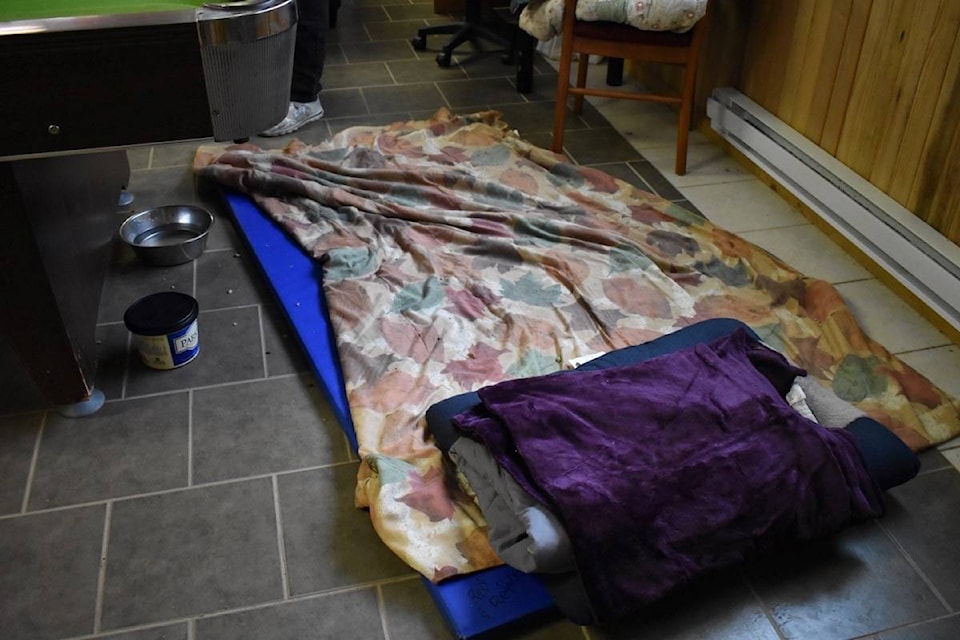As cold, wet weather descends upon Hope, those who would normally seek shelter from it may not have anywhere to turn.
Normally come Nov. 1, an extreme weather response (EWR) is activated and lasts until March 31. In previous years, what EWR looked like was Hope’s emergency shelter providing a communal space where 10 to 15 people could be accommodated when temperatures dipped below zero or when there were long periods of cold, wet weather. This was in addition to the 20 permanent spaces at Hope’s emergency shelter.
Yet with limited capacity at the shelter due to the ongoing pandemic, the Hope and Area Transition Society (HATS) won’t be operating EWR this year.
“We’re concerned,” said executive director Gerry Dyble. “We still have a gap there…we normally would be servicing folks who we are not going to be able to serve this year.”
HATS operates Hope’s only emergency shelter, which currently has 26 spaces. This include 11 spaces at the shelter and 15 hotel rooms, clients are spaced out to ensure pandemic protocols can be followed. Twenty four of these spaces are full as of Oct. 26.
The Jean Scott Transition House, which provides a space for women fleeing violence, has also had their capacity halved from eight to four beds due to the pandemic. “It doesn’t take long to fill four beds,” Dyble said.
The need exists, as evidenced by those 10 to 15 extreme weather spaces consistently being filled in previous years. The shelter has already been to full to accommodate the need – over the past weekend two people were turned away.
Dyble said she has been talking with BC Housing about EWR since April. She has also been in communication with the District of Hope, Fraser Health and the RCMP. She stressed that while HATS is a service provider that provides shelter and outreach to people who are homeless, work on homelessness in Hope cannot rest solely with HATS.
“What we really want the community to know is, homelessness is not a HATS issue…This is a community issue. We’ve reached out to our churches and the capacity just isn’t there to meet the needs,” she said.
“It’s a unique space that we need,” Dyble explained. It needs to be an open one where staff can have their eyes on clients, so renting a motel room wouldn’t solve this need, she said. Other requirements include shower facilities, capacity to supply food and to ensure bedbug protocol can be followed so that the spaces being used aren’t affected by bedbugs.
Mayor Peter Robb agreed that finding a space has been difficult. So far the church halls have not expressed interest, he said, and other communal spaces don’t have the needed showers and bathroom facilities. “Our community needs it, there is a need for extreme weather shelter. But right now we do not have a solution,” Robb said, adding that the district is continuing to work with HATS to find a space.
BC Housing stated that they are also working with HATS and the district to find an “appropriate place to open an extreme weather response shelter this season” and are considering “all potential locations.”
The extreme weather response by HATS is a 24/7 operation, meaning clients can stay in the space during the day and don’t have to pack their things and head outdoors into the cold in the mornings as most extreme weather response is done in the Lower Mainland.
“We typically don’t warm up once we hit the cold months, we don’t warm up past zero a lot of the times during the day, so we run it 24/7,” Dyble said. This also means that two staff have to be on at all times, 24 hours a day.
Meanwhile Dyble said HATS are still trying to problem solve, to be able to accommodate a few more people, although this won’t make up for the amount of space that existed in previous years when the weather turned ugly.
The lack of space is compounding difficulties already faced by people who are homeless in Hope, who have seen fewer places to spend time indoors during the day as public spaces have either closed or limited their occupancy.
“COVID has impacted the ability for our unsheltered population to actually go in and seek some refuge, even during the day, whether that was the rec centre or the library,” Dyble said.
Do you have something to add to this story, or something else we should report on? Email:
emelie.peacock@hopestandard.com
